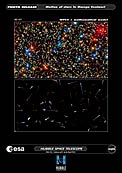Using Hubble to chart the future motions of stars within a cluster
The multi-colour snapshot (top), taken with the Wide Field Camera 3 aboard the NASA/ESA Hubble Space Telescope, captures the central region of the giant globular cluster Omega Centauri. All the stars in the image are moving in random directions, like a swarm of bees. Astronomers used Hubble’s exquisite resolving power to measure positions for stars in 2002 and 2006.
From these measurements, they can predict the stars’ future movement. The lower illustration charts the future positions of the stars highlighted by the white box in the top image. Each streak represents the motion of the stars over the next 600 years. The motion between the dots corresponds to 30 years.
Credit:NASA, ESA, J. Anderson and R. van der Marel (STScI)
About the Image
| Id: | heic1017a |
| Type: | Collage |
| Release date: | 26 October 2010, 15:05 |
| Related releases: | heic1017 |
| Size: | 1980 x 2295 px |
About the Object
| Name: | NGC 5139, Omega Centauri |
| Type: | Milky Way : Star : Grouping : Cluster : Globular |
| Distance: | 15000 light years |
| Category: | Star Clusters |
Colours & filters
| Band | Wavelength | Telescope |
|---|---|---|
| Ultraviolet U | 223 nm |
Hubble Space Telescope
WFC3 |
| Ultraviolet U | 336 nm |
Hubble Space Telescope
WFC3 |
| Infrared I | 814 nm |
Hubble Space Telescope
WFC3 |

